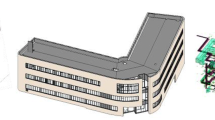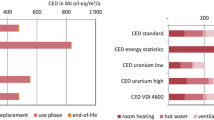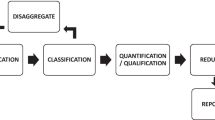Abstract
Purpose
Data centres are high-energy consumers, and historical assessment of their environmental impact has focused largely on energy consumption. Widely adopted assessment methods consider either single issues or do not comprehensively assess links between issues. One exception is the CLEER Model, which compares life cycle energy and greenhouse gas (GHG) emissions of Cloud-based and present-day services. However, there remains the need to verify components for inclusion in a data centre life cycle assessment (LCA), assess quality and quantity of secondary data, benchmark an existing data centre LCA, assess non-Cloud-based services for multiple impacts, and establish facility areas that are sensitive to change.
Methods
A hybrid approach, combining process-based and economic input output (EIO) data, was used to perform the screening LCA of an existing UK data centre. The study includes the definition of the goal and scope, modelling assumptions, a life cycle inventory, results and interpretation and a sensitivity check.
Results and discussion
The dominance of the information technology (IT) operational phase to the overall impact and the severity of the impact on human health are concluded. Due to the use of free cooling, the IT-embodied impact is greater than the combined mechanical and electrical operational impact. Electricity production dominates the total life cycle impact; however, the second most significant impact derives from the disposal of metal refining waste products during the manufacture of IT components and electricity distribution networks. The release of carcinogens is one of the largest contributors to the whole life cycle impact and is almost equal in value between the embodied and operational phases. Finally, a sensitivity check found that a Swedish facility optimised for operational energy efficiency with a 1.25-year server refresh resulted in an embodied impact almost double the operational.
Conclusions
It was concluded that current LCI data, software packages and project data allow for a sufficiently accurate data centre LCA model. The results support the need to broaden environmental impact reduction to beyond operational energy consumption for cooling and that building environmental assessment methods (BEAMs) should consider more embodied impacts. It is concluded also that three parameters are sensitive to design changes that influence the overall impact: operational energy for the IT equipment, cooling and power delivery; the energy mix; and the amount of IT equipment across the facility’s lifetime. The results present a clear need to monitor life cycle impact, develop further tools to compare different design/operation options and functional units, improve data and develop an LCA-based BEAM.














Similar content being viewed by others
References
Angrill S, Farreny R, Gasol C et al (2012) Environmental analysis of rainwater harvesting infrastructure in diffuse and compact urban models of Mediterranean climate. Int J Life Cycle Assess 17(1):25–42
Barroso LA, Hölzle U (2009) The data centre as a computer: an introduction to the design of warehouse-scale machines. doi:10.2200/s00193ed1v01y200905cac006
Baumann H, Tillman A-M (2009) The hitch hiker’s guide to LCA. Studentlitteratur AB, Sweden
Bribian IZ, Capilla AV, Uson AA (2011) Life cycle assessment of building materials: comparative analysis of energy and environmental impacts and evaluation of the eco-efficiency improvement potential. Build Environ 46(5):1133–1140
BSI (1964) BS 648:1964 schedule of weights of building materials. BSI, London
BSI (2011) BS EN 15978:2011 sustainability of construction works—assessment of environmental performance of buildings—calculation method. BSI, London
Chang J, Meza J, Ranganathan P, Shah A, Shih R, Bash C (2012) Totally green: evaluating and designing servers for lifecycle environmental impact. In: Proceedings of ASPLOS’12, the Seventeenth International Conference on Architectural Support for Programming Languages and Operating Systems, New York, USA, 3–7 March 2012. doi:10.1145/2150976.2150980
Chang Y, Ries RJ, Lei S (2012b) The embodied energy and emissions of high-rise education building: a quantification using process-based hybrid life cycle inventory model. Energy Build 55:790–798
CIBSE (2008) Guide M: maintenance engineering and management (CIBSE guide M). CIBSE, London
Dones R, Bauer C, Bolliger R, Burger B, Heck T, Roder A, Emmenegger MF, Frischknecht R, Jungbluth N, Tuchschmid M (2007) Life cycle inventories of energy systems: results for current systems in Switzerland and other UCTE countries. Data v2.0(2007). Ecoinvent report no. 5. http://www.ecolo.org/documents/documents_in_english/Life-cycle-analysis-PSI-05.pdf. Accessed 26 June 2013
Frischknecht R, Jungbluth N (eds) (2007) Overview and methodology. Data v2.0 (2007). Ecoinvent report no. 1. http://www.ecoinvent.org/fileadmin/documents/en/01_OverviewAndMethodology.pdf. Accessed 25 June 2013
Frischknecht R, Althaus H-J, Bauer C, Doka G, Heck T, Jungbluth N, Kellenberger D, Nemecek T (2007) The environmental relevance of capital goods in life cycle assessments of products and services. Int J Life Cycle Assess 12(Special Issue 1):7–17
Fujitsu (2010) Life cycle assessment and product carbon footprint. Primergy TX 300S5 and PRIMERGY RX 300 S5 Server. White paper. http://fujitsu.fleishmaneurope.de/wp-content/uploads/2010/12/LCA_PCF-Whitepaper-PRIMERGY-TX-RX-300-S5.pdf. Accessed 1 Feb 2012
Hischier R, Weidema B (eds) (2010) Implementation of life cycle impact assessment methods. Data v2.2. Ecoinvent report no. 3. http://www.ecoinvent.org/fileadmin/documents/en/03_LCIA-Implementation-v2.2.pdf. Accessed 25 June 2013
Intel (2009) The problem of power consumption in servers, InfoQ. http://www.infoq.com/articles/power-consumption-servers. Accessed 2 June 2012
ISO (2006) BS EN ISO 14044:2006 environmental management. Life cycle assessment. Principles and frameworks. BSI, London
ISO (2008) BS ISO 15686–5:2008 buildings & constructed assets—service life planning—part 5: life cycle costing. BSI, London
Koomey JG (2007) Estimating total power consumption by servers in the US and the world. http://sites.amd.com/us/Documents/svrpwrusecompletefinal.pdf. Accessed 8 Oct 2010
Koomey JG (2011) Growth in data center electricity use 2005 to 2010. http://www.analyticspress.com/datacenters.html. Accessed 1 Feb 2012
Langdon D (2011) Spon’s mechanical and electrical services price book 2011. Spon Press, London
LBNL (2014) CLEER model—Cloud energy and emissions research model. Public use model. http://cleermodel.lbl.gov/. Accessed 17 Nov 2014
Lettieri DJ, Shah AJ, Carey VP (2009) Exergy-based environmental design of a computer room air conditioning unit. ASME, Lake Buena Vista. doi:10.1115/IMECE2009-11461
Nicholson AL, Olivetti EA, Gregory JR et al (2009) End-of-life LCA allocation methods: open loop recycling impacts on robustness of material selection decisions. ISSST, Phoenix. doi:10.1109/ISSST.2009.5156769
Norris GA (2006) Social impacts in product life cycles. Towards life cycle attribute assessment. Int J Life Cycle Assess 11(Special Issue 1):97–104
Prek M (2004) Environmental impact and life cycle assessment of heating and air conditioning systems, a simplified case study. Energy Build 36(10):1021–1027
Ramakrishnan N, Marwah M, Shah A, Patnaik D, Hossain MS, Sundaravaradan N, Patel C (2012) Data mining solutions for sustainability problems. IEEE Potentials 31(6):28–34
Sára B, Scimìa E, Cappellaro F, Maccallini V, Masoni P (2006) Life cycle assessment of an innovative uninterruptible power supply system to investigate on environmental performance. Care Innovation, Vienna, Austria. http://www.ecosmes.net/pneumaprj/web/jsp/utils/docsView.jsp?d=30&l=EN. Accessed 29 March 2011
Schmidt M, Hottenroth H, Schottler M, Fetzer G, Schlüter B (2011) Life cycle assessment of silicon wafer processing for microelectronic chips and solar cells. Int J Life Cycle Assess 17(2):126–144
Shah A, Lugo W, Patel C (2009) Thermodynamics-based object-oriented environmental design of an industrial air conditioner. ASME, San Francisco. doi:10.1115/HT2009-88105
Shah A, Chen Y, Bash CE (2012) Sources of variability in data center lifecycle assessment. In: Proceedings of IEEE International Symposium on Sustainable Systems and Technology (ISSST), Boston. doi:10.1109/ISSST.2012.6227975
Skaar C, Jørgensen RB (2013) Integrating human health impact from indoor emissions into an LCA: case study evaluating the significance of the use stage. Int J Life Cycle Assess 18(3):636–646
Song Q, Wang Z, Li J, Yuan W (2012) Life cycle assessment of desktop PCs in Macau. Int J Life Cycle Assess 8(13):553–566
The Green Grid (2012) Data centre life cycle assessment guidelines. White Paper #45, v2. http://www.thegreengrid.org/library-and-tools.aspx. Accessed 20 Nov 2012
The Green Grid (2013) Electronics disposal efficiency (EDE): an IT recycling metric for enterprises and data centers. White Paper #53. http://www.thegreengrid.org/library-and-tools.aspx. Accessed 7 Mar 2013
Uddin M, Rahman AA (2012) Energy efficiency and low carbon enabler green IT framework for data centers considering green metrics. Renew Sustain Energy Rev 16(6):4078–4094
US Department of Labor Bureau of Statistics (2012) Consumer price index. All urban consumers. US city average. All items. ftp://ftp.bls.gov/pub/special.requests/cpi/cpiai.txt. Accessed 2 Feb 2012
US Census Bureau (2011a) The 2012 statistical abstract: historical data. http://www.census.gov/compendia/statab/hist_stats.html. Accessed 2 Feb 2012
US Census Bureau (2011b) No. HS-36. Consumer and gross domestic price indexes: 1913 to 2002. http://www.census.gov/statab/hist/HS-36.pdf. Accessed 2 Feb 2012
VROM—Ministry of Housing, Spatial Planning and the Environment (2000) Eco-indicator 99 manual for designers. http://www.pre-sustainability.com/content/reports. Accessed 19 Mar 2013
Weidema BP, Wesnaes MS (1996) Data quality management for life cycle inventories—an example of using data quality indicators. J Clean Prod 4(3–4):167–174
Whitehead B, Andrews D, Shah A, Maidment G (2014a) Assessing the environmental impact of data centres part 1: background, energy use and metrics. Build Environ 82:151–159
Whitehead et al (2014b) Assessing the environmental impact of data centres part 2: building environmental assessment methods and life cycle assessment. Build Environ. doi:10.1016/j.buildenv.2014.08.015
WRAP (2010) CON900-001: construction, demolition and excavation waste arisings, use and disposal for England 2008. http://www.wrap.org.uk/downloads/CDEW_arisings_use_and_disposal_for_England_2008.1e8085ab.9526.pdf. Accessed 3 Jan 2012
Acknowledgments
This paper has been developed with the financial support of the Engineering and Physical Sciences Research Council (EPSRC) and HP, who have also gone to great lengths to share their knowledge and expertise in the fields of data centres and sustainable IT. Additional support and review of work was provided by supervisors: Dr Robert Tozer, Dr Alan Dunn, Professor Graeme Maidment and Sophia Flucker. A final thank you should go to Almut Beate Heinrich and Walter Klöpffer for their input in publishing this paper.
Author information
Authors and Affiliations
Corresponding author
Additional information
Responsible editor: Walter Klöpffer
Rights and permissions
About this article
Cite this article
Whitehead, B., Andrews, D. & Shah, A. The life cycle assessment of a UK data centre. Int J Life Cycle Assess 20, 332–349 (2015). https://doi.org/10.1007/s11367-014-0838-7
Received:
Accepted:
Published:
Issue Date:
DOI: https://doi.org/10.1007/s11367-014-0838-7




